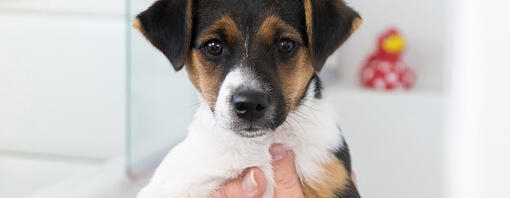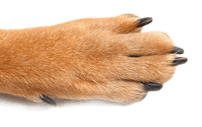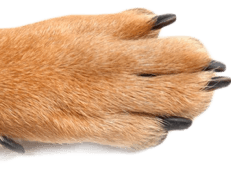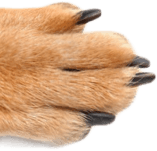
Learn how to ensure your puppy is happy being handled with our step-by-step guide. This includes day to day care, play, social interactions and grooming.
Part of life with our dogs includes enjoying physical contact - whether that is stroking, snuggling up together on the sofa or grooming your dog to keep them clean, healthy and looking at their best.
It is also going to be important in keeping them safe, that they are happy for you catch them and take hold of their harness or collar, restrain them if necessary, and that they not avoid your touch.
It is important that from the very start of your puppy's life with you that they learn to enjoy your touch and to trust your hands - and this is part of the early life skills lessons you and your puppy are going to learn together.
Why Do Some Puppies Dislike Being Handled?
Handling problems nearly always have their roots in puppyhood - or else in bad experiences.
When a puppy first comes home, they are babies with no way to protest against rough handling or handling that scares or overwhelms them. Often people unthinkingly grab, hold, hug and lift puppies - often with no warning, ignoring struggles and protests - and force them into interactions like being groomed or rough play. In many cases, this is done with the best intentions to 'get them used to being handled' but it has the opposite effect.
A puppy doesn't have the strength or behavioural competencies to object or have those objections taken seriously, but they are learning not to trust their family or enjoy their touch. This will come out in a far more obvious way as the dog matures and gets bigger and stronger.
In other cases, it can come from a bad experience. Things like constantly being grabbed, an owner catching the quick when clipping claws, or something scary happening, can have lasting effects.
Like some humans, some dogs are very tactile and love being touched and having close physical contact with their owners. Others are less tolerant of over-handling, perhaps because they find it too intense, get bored, get frustrated or just don't like it. Other never have the experience of learning to enjoy being handled when they are younger and so this gets carried on in later life. It might be they don't like being handled at all, or else there are some places on their body (paws for example) that they object to being touched.
How to teach a Puppy to Enjoy Being Handled
This is a life skill and not a training exercise - and so is something you and everyone in the family have to think about 24/7. It's easy to think about training your dog as something you only do for half an hour a day in 'training sessions' but the reality is that your dog is learning something from you every minute of the day - and one of those things is how much they trust you, how much they trust your hands, and how much of a bond they have with you. This is going to have a direct result on how much they learn to enjoy being handled.
Starting Off Handling Your Puppy
In the first few days of your life together, you and everyone in the family are going to be really excited about the new arrival. It is important to remember however that for your puppy, everything in their life and everything that was familiar has changed and they are away from their canine family for the first time in their life. They are also with total strangers.
Let them approach you and lead all the physical interactions. Get down on the floor and let them sniff you, investigate you, climb on you if they want to without you trying to hold them, cuddle them or restrain them. Especially let them investigate your hands - and if they seem happy and confident, you can have a stroke or a gentle rub behind the ears.
If you have to pick them up (to take them outside for a pee etc), make sure they see you coming, you pick them up gently, and that you don't lift them high.
When you are playing, do not push them around with your hands - no matter how enthusiastic they seem to be.
Be mindful of the experience your puppy is having every time you interact with them. As examples, don't put their harness on roughly or grab it. Don't close loud clips near their ear. Don't force interactions - if you're stroking your puppy and they want to leave, let them.
These early days are about them learning to trust you and to start to build a bond between you.
Next Steps in Puppy Handling
Once your puppy has settled into their new life, there are other things you can do to teach them to be happy with people hands and being handled. These are things you can do when your puppy has just come home and are also things you can do with a rescue dog.
Increasing touch
When your puppy is relaxing with you, you can get them used to being stroked and touched - first in the areas they enjoy but also slowly building up to stroking down legs, and around their head and face.
If the dog is relaxed about this, all members of the family can do this - although children should always be supervised.
The Law of Consent
This is for puppies and adult dogs. It's easy to force interactions on a dog without even thinking about it. People often grab, hug or hang on to dogs without even considering if the dog is enjoying the interaction. If you doubt it, look at social media and it is full of people hugging their dog for photos while the dog's body language is making it clear that they are hating every second.
Practise consent (and get everyone in the family to do the same thing).
- Wait for your dog to come to interact with you.
- When they do, you can stroke them, give them bottom scritches - or anything else you know they enjoy.
- Do this for 5 seconds only and then stop.
- If your dog moves away, you don't have their consent to continue.
- If they stay and encourage you to continue, then you can do so - for another 5 seconds. And so on.
By doing this, you are making sure your interactions are as enjoyable for your dog as they are for you - and that your dog is a willing partner. They will also learn that they can control the interactions - and for puppies or dogs who don't know their new owners, this is important in building a strong bond.
Hand touches
You can also teach your dog to touch your hand with their nose. This is a fun exercise which is the start of some other cool tricks like shutting doors etc - but as a starting point, it teaches dogs that interacting with hands brings rewards.
What you will need:
Some really tasty treats
- While you are interacting with your dog, hold your hand out flat with your palm towards your dog
- Most dogs will come and investigate the hand
- The instant your dog's nose touches your hand, use your reward word and give them a treat from your other hand.
- Repeat and practise
You are teaching your dog that contact with your hands is rewarding - and that you won't grab them.
Gentle restraint
For an active puppy, being held onto can be frustrating and it is important that they learn to deal with that frustration in a positive way. This comes from introducing very short periods of restraint into your play and interactions.
- While you are interacting with your puppy - and they are not too excited - link your hands around the front of their chest to prevent them going anywhere for a few seconds. Then release them with loads of praise and continue the interaction.
- Always try to release them before they get frustrated about the restraint - you are aiming to teach them to be happy with these gentle interruptions, so it becomes a normal occurrence.
- Practise this at least once every day.
Harness 'grabs'
In emergencies, there are going to be times you are going to have to catch your dog quickly, so it is good to practise this as part of your life skills training.
- Have some play sessions with your puppy's harness on.
- While you are giving them a treat, slip your fingers in the harness and hold on to it for a few seconds before releasing it
- Do this a few times - before repeating while giving it a couple of gentle tugs.
- Introduce this into games, play and general interactions.
- Remember when you are practising recall to slip your fingers in your dog's harness as you give the reward
You are aiming to have a puppy who is happy for you to take hold of their harness and is used to you doing this. You can do this if your puppy wears a collar too but be careful not to scare them with your hands reaching near their face as this can teach a dog to be 'collar shy' and back away from your hands.
Obviously there are going to be times when you are going to have to catch your puppy, hold on to them etc but if you have already built up positive associations with hands and handling, and being caught, your dog is going to be quite happy about that - although remember always to be gentle as they are learning and making associations 24/7.
If you have a dog who already doesn't enjoy being touched, can't be handled, or who you are worried about becoming aggressive, talk to an accredited behaviourist as a matter of urgency. For more information read our article on how to stop aggressive dog behaviour.
By starting off right with your puppy and teaching them that your hands and being handled is a good thing, you are teaching them to trust you, deepening the bond between you, and ensuring that you can handle them whenever and wherever you need to. It also increases the likelihood that they will solicit affection and interactions with you - which is what we all want from our dogs.




